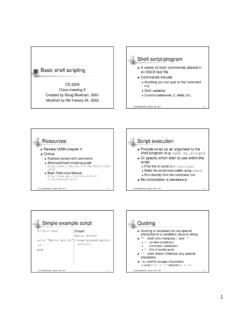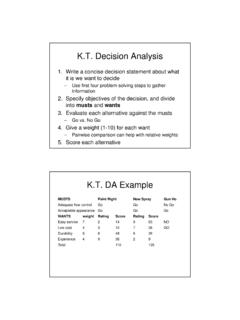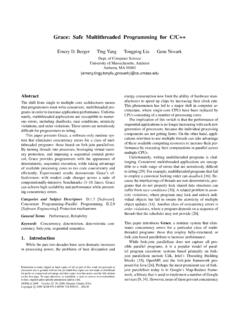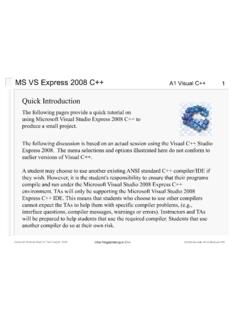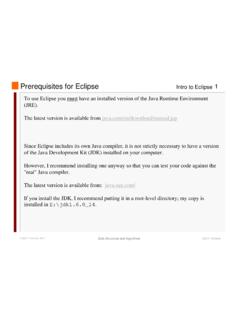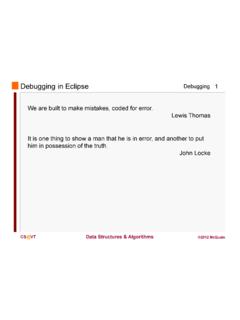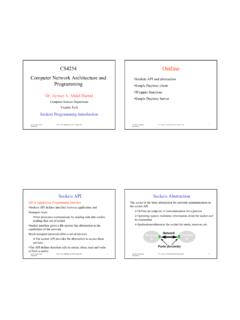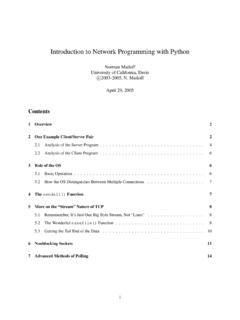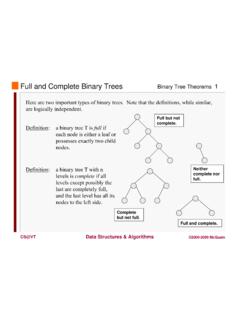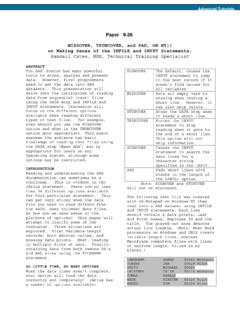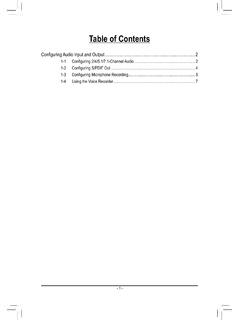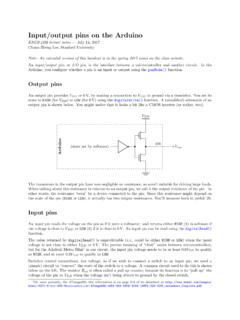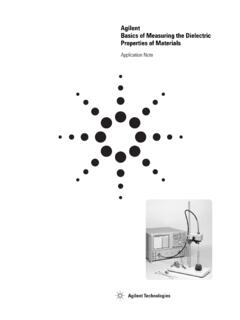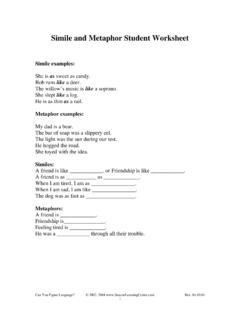Transcription of C++ Input/Output: Streams
1 Computer Science Dept Va Tech August, 2001 1995-2001 Barnette ND & McQuain WD14. input /OutputIntro Programming in C++C++ input / output : StreamsThe basic data type for I/O in C++ is the stream. C++ incorporates a complex hierarchy of stream types. The most basic stream types are the standard input / output Streams :istream cinbuilt-in input stream variable; by default hooked to keyboardostream coutbuilt-in output stream variable; by default hooked to consoleheader file: <iostream>C++ also supports all the input / output mechanisms that the C language included. However, C++ Streams provide all the input / output capabilities of C, with substantial will exclusively use Streams for input and output of Science Dept Va Tech August, 2001 1995-2001 Barnette ND & McQuain WD24. input /OutputIntro Programming in C++C++ Streams are ObjectsThe input and output Streams , cinand coutare actually C++ objects. Briefly:class:a C++ construct that allows a collection of variables, constants, and functions to be grouped together logically under a single nameobject:a variable of a type that is a class (also often called an instance of the class)For example, istreamis actually a type name for a class.
2 Cinis the name of a variable of type istream. So, we would say that cinis an instanceor an objectof the class instance of a class will usually have a number of associated functions (called member functions) that you can use to perform operations on that object or to obtain information about it. The following slides will present a few of the basic stream member functions, and show how to go about using member are one of the fundamental ideas that separate C++ from C. In this course, we will explore the standard stream classes and the standard string Science Dept Va Tech August, 2001 1995-2001 Barnette ND & McQuain WD34. input /OutputIntro Programming in C++Conceptual Model of a StreamA stream provides a connection between the process that initializes it and an object, such as a file, which may be viewed as a sequence of data. In the simplest view, a stream object is simply a serialized view of that other object. For example, for an input stream:To be, or not to be?
3 That is the fileexecuting processWe think of data as flowing in the stream to the process, which can remove data from the stream as desired. The data in the stream cannot be lost by flowing past before the program has a chance to remove stream object provides the process with an interface to the Science Dept Va Tech August, 2001 1995-2001 Barnette ND & McQuain WD44. input /OutputIntro Programming in C++To get information out of a file or a program, we need to explicitly instruct the computer to output the desired way of accomplishing this in C++ is with the use of an output stream. In order to use the standard I/O Streams , we must have in our program the pre-compiler directive: #include <iostream>In order to do output to the screen, we merely use a statement like:cout << " X = " << X;where X is the name of some variable or constant that we want to write to the to an output stream can be "chained" together as shown here. The left-most side mustbe the name of an output stream variable, such as : the Insertion OperatorHint: the insertion operator (<<) points in the direction the data is Science Dept Va Tech August, 2001 1995-2001 Barnette ND & McQuain WD54.
4 input /OutputIntro Programming in C++ output Examplescout << "CANDLE" << endl;cout << "STICK" << endl;endlis a manipulatoris a C++ construct that is used to control the formatting of output and/or input can only be present in input / output statements. The endlmanipulator causes a newlinecharacter to be defined in the <iostream>header file and can be used as long as the header file has been the name of a variable or constant to a stream causes the value of that object to be written to the stream:const string Label = "Pings echoed:";int totalPings = 127;cout << Label << totalPings << endl;Pings echoed: 127No special formatting is supplied by , line breaks, etc., must all be controlled by the programmer:cout << "CANDLE";cout << "STICK" << endl;Computer Science Dept Va Tech August, 2001 1995-2001 Barnette ND & McQuain WD64. input /OutputIntro Programming in C++ input : the Extraction OperatorTo get information into a file or a program, we need to explicitly instruct the computer to acquire the desired way of accomplishing this in C++ is with the use of an input stream.
5 As with the standard input stream, cout, the program must use the pre-compiler directive: #include <iostream>In order to do output , we merely use a statement like:cin >> X;where Xis the name of some variable that we want to store the value that will be read from the keyboard. As with the insertion operator, extractions from an input stream can also be "chained". The left-most side mustbe the name of an input stream : the extraction operator (>>) points in the direction the data is Science Dept Va Tech August, 2001 1995-2001 Barnette ND & McQuain WD74. input /OutputIntro Programming in C++ input ExamplesAssume the input stream cincontains the data:12 -19 Then:int A, B;double X;cin >> A; // A <--- 12cin >> X; // X <--- >> B; // B <--- -19If we start each time with the same initial values in the stream:int A, B;char C;cin >> A; // A <--- 12cin >> B; // B <--- 17cin >> C; // C <--- '.'cin >> A; // A <--- 3int A;char B, C, D;cin >> A; // A <--- 12cin >> B; // B <--- '1'cin >> C; // C <--- '7'The extraction operator is "smart enough" to consider the type of the target variable when it determines how much to read from the input Science Dept Va Tech August, 2001 1995-2001 Barnette ND & McQuain WD84.
6 input /OutputIntro Programming in C++stringInput with ExtractionThe extraction operator may be used to read characters into a string extraction statement reads a whitespace-terminated string into the target string, ignoring any leading whitespace and not including the terminating whitespace character in the target amount of storage allocated for the string variables will be adjusted as necessary to hold the number of characters read. (There is a limit on the number of characters a string variable can hold, but that limit is so large it is of no practical concern.)Of course, it is often desirable to have more control over where the extraction the input stream cincontains the data:Flintstone, Fred :string L, F;double X;cin >> L; // L <--- "Flintstone,"cin >> F; // F <--- "Fred"cin >> X; // X <--- Science Dept Va Tech August, 2001 1995-2001 Barnette ND & McQuain WD94. input /OutputIntro Programming in C++Extraction Operator and WhitespaceIn programming, common characters that do not produce a visible image on a page or in a file are referred to as most common whitespace characters are:\vvertical tab\rcarriage return(space)blank\ttab\nnewlineCodeName By default, the extraction operator in C++ will ignore leadingwhitespace is, the extraction operator will remove leading whitespace characters from the input stream and discard if we need to read and store whitespace characters?
7 See the get()function later in the Science Dept Va Tech August, 2001 1995-2001 Barnette ND & McQuain WD104. input /OutputIntro Programming in C++Details of an Extractioncin >> X;Assume the input stream cin contains:12 -19 The numbers are separated by some sort of whitespace, say by that Xis declared as an int, and the following statement is executed:The type of the targeted variable, Xin this case, determines how the extraction is performed. First, any leading whitespace characters are an integer value is being read, the extraction will stop if a character that couldn't be part of an integer is , the digits '1' and '2' are extracted, and the next character is a tab, so the extraction stops and Xgets the value tab after the '2' is left in the input Science Dept Va Tech August, 2001 1995-2001 Barnette ND & McQuain WD114. input /OutputIntro Programming in C++ignore()Member FunctionThere is also a way to remove and discard characters from an input (N, ch);means to skip (read and discard) up to Ncharacters in the input stream, oruntil the character chhas been read and discarded, whichever comes first.
8 (80, '\n');says to skip the next 80 input characters orto skip characters until a newline character is read, whichever comes ignore function can be used to skip a specific number of characters or halt whenever a given character (100, '\t');means to skip the next 100 input characters, or until a tab character is read, or whichever comes Science Dept Va Tech August, 2001 1995-2001 Barnette ND & McQuain WD124. input /OutputIntro Programming in C++Interactive I/OPrompts: users must be given a cue when and what they need to input :const string AgePrompt = "Enter your Age: ";cout << AgePrompt;cin >> UserAge;The statements above allow the user to enter her/his age in response to the prompt. Because of buffering of the I/O by the computer, it is possible that the prompt may notappear on a monitor before the program expects input to be ensure output is sent to its destination immediately:cout << AgePrompt << flush;cin >> UserAge;The manipulator flushensures that the prompt will appear on the display before the input is manipulator endlincludes a implicit Science Dept Va Tech August, 2001 1995-2001 Barnette ND & McQuain WD134.
9 input /OutputIntro Programming in C++C++ also provides stream types for reading from and writing to files stored on disk. For the most part, these operate in exactly the same way as the standard I/O Streams , cinand basic file I/O:#include <fstream>There are no pre-defined file stream variables, so a programmer who needs to use file Streams must declare file stream variables:ifstream inFile; // input file stream objectofstream outFile; // output file stream objectThe typesifstreamand ofstreamare C++ stream classes designed to be connected to input or output files. File stream objects have all the member functions and manipulators possessed by the standard Streams , cinand for File I/OComputer Science Dept Va Tech August, 2001 1995-2001 Barnette ND & McQuain WD144. input /OutputIntro Programming in C++By default, a file stream is not connected to anything. In order to use a file stream the programmer must establish a connection between it and some file. This can be done in two may use the open()member function associated with each stream (" "); (" ");This sets up the file Streams to read data from a file called " " and write output to a file called " ".
10 For an input stream, if the specified file does not exist, it will notbe created by the operating system, and the input stream variable will contain an error flag. This can be checked using the member function fail()discussed on a later an output stream, if the specified file does not exist, it will be created by the operating Streams to FilesComputer Science Dept Va Tech August, 2001 1995-2001 Barnette ND & McQuain WD154. input /OutputIntro Programming in C++You may also connect a file stream variable to a file when the stream variable is declared:ifstream inFile(" ");ofstream outFile(" ");This also sets up the file Streams to read data from a file called " " and write output to a file called " ". The only difference between this approach and using the open()function is : if you use a stringconstant (or variable) to store the file name, you must add a special conversion when connecting the stream:string inputFileName = " ";ifstream inFile( ());Connecting Streams to FilesComputer Science Dept Va Tech August, 2001 1995-2001 Barnette ND & McQuain WD164.
